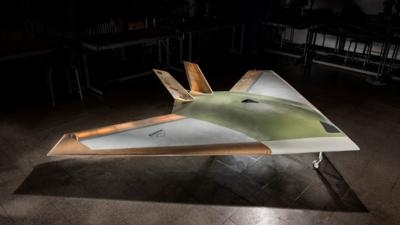Mon, Dec 18, 2017
BAE Systems And The University Of Manchester Seek To Change The Future Of Aircraft Design
BAE Systems and The University of Manchester have successfully completed the first phase of flight trials with MAGMA – a small scale unmanned aerial vehicle (UAV) which will use a unique blown-air system to maneuver the aircraft - perhaps leading to stealthier aircraft designs in the future.

The new concept for aircraft control removes the conventional need for complex, mechanical moving parts used to move flaps to control the aircraft during flight. This could give greater control as well as reduce weight and maintenance costs, allowing for lighter, stealthier, faster and more efficient military and civil aircraft in the future.
The two technologies to be trialled first using the jet-powered UAV, MAGMA, are:
Wing Circulation Control, which takes air from the aircraft engine and blows it supersonically through the trailing edge of the wing to provide control for the aircraft
Fluidic Thrust Vectoring, which uses blown air to deflect the exhaust, allowing for the direction of the aircraft to be changed.
The flight trials are part of an ongoing project between the two organizations and wider long-term collaboration between industry, academia and government to explore and develop innovative flight control technology. Further flight trials are planned for the coming months to demonstrate the novel flight control technologies with the ultimate aim of flying the aircraft without any moving control surfaces or fins. If successful, the tests will demonstrate the first ever use of such circulation control in flight on a gas turbine aircraft and from a single engine.
"The technologies we are developing with The University of Manchester will make it possible to design cheaper, higher performance, next generation aircraft," said Clyde Warsop, Engineering Fellow at BAE Systems. "Our investment in research and development drives continued technological improvements in our advanced military aircraft, helping to ensure UK aerospace remains at the forefront of the industry and that we retain the right skills to design and build the aircraft of the future.”
"These trials are an important step forward in our efforts to explore adaptable airframes," said Bill Crowther, a senior academic and leader of the MAGMA project at The University of Manchester. "What we are seeking to do through this programme is truly ground-breaking.”
Additional technologies to improve the performance of the UAV are being explored in collaboration with the University of Arizona and NATO Science and Technology Organization.
(Image provided with BAE news release)
More News
Mid-Continent Instruments and Avionics and True Blue Power ANN's NBAA 2025 Coverage... Visit Them At Booth #3436 True Blue Power Introduces New 45-watt Charging Ports for 14- and 2>[...]
En Route Automation System (EAS) The complex integrated environment consisting of situation display systems, surveillance systems and flight data processing, remote devices, decisi>[...]
“Our Kodiak aircraft family is uniquely designed to meet the rigorous demands of such deployments, bringing short takeoff and landing performance, robust cargo capacity and e>[...]
Aero Linx: Australian Society of Air Safety Investigators (ASASI) The Australian Society of Air Safety Investigators (ASASI) was formed in 1978 after an inaugural meeting held in M>[...]
Left Main Landing Gear Struck A Bush, And The Right Wingtip Impacted The Ground Analysis: According to the pilot of the tailwheel-equipped airplane, he noticed that the engine oil >[...]
 True Blue Power and Mid-Continent Instruments and Avionics Power NBAA25 Coverage
True Blue Power and Mid-Continent Instruments and Avionics Power NBAA25 Coverage ANN's Daily Aero-Term (10.15.25): En Route Automation System (EAS)
ANN's Daily Aero-Term (10.15.25): En Route Automation System (EAS) Aero-News: Quote of the Day (10.15.25)
Aero-News: Quote of the Day (10.15.25) ANN's Daily Aero-Linx (10.15.25)
ANN's Daily Aero-Linx (10.15.25) NTSB Final Report: Jeremy S Lezin Just SuperSTOL
NTSB Final Report: Jeremy S Lezin Just SuperSTOL



